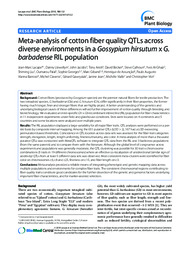Meta-analysis of cotton fiber quality QTLs across diverse environments in a Gossypium hirsutum x G. barbadense RIL population.
Meta-analysis of cotton fiber quality QTLs across diverse environments in a Gossypium hirsutum x G. barbadense RIL population.
Autoria: LACAPE, J.- M.; LLEWELLYN, D.; JACOBS, J.; ARIOLI, T.; BECKER, D.; CALHOUN, S.; AL-GHAZI, Y.; LIU, S.; PALAI, O.; GEORGES, S.; GIBAND, M.; ASSUNÇÃO, H. de; BARROSO, P. A. V.; CLAVERIE, M.; GAWRYZIAK, G.; JEAN, J.; VIALLE, M.; VIOT, C.
Resumo: Background: Cotton fibers (produced by Gossypium species) are the premier natural fibers for textile production. The two tetraploid species, G. barbadense (Gb) and G. hirsutum (Gh), differ significantly in their fiber properties, the former having much longer, finer and stronger fibers that are highly prized. A better understanding of the genetics and underlying biological causes of these differences will aid further improvement of cotton quality through breeding and biotechnology. We evaluated an inter-specific Gh × Gb recombinant inbred line (RIL) population for fiber characteristics in 11 independent experiments under field and glasshouse conditions. Sites were located on 4 continents and 5 countries and some locations were analyzed over multiple years. Results: The RIL population displayed a large variability for all major fiber traits. QTL analyses were performed on a persite basis by composite interval mapping. Among the 651 putative QTLs (LOD > 2), 167 had a LOD exceeding permutation based thresholds. Coincidence in QTL location across data sets was assessed for the fiber trait categories strength, elongation, length, length uniformity, fineness/maturity, and color. A meta-analysis of more than a thousand putative QTLs was conducted with MetaQTL software to integrate QTL data from the RIL and 3 backcross populations (from the same parents) and to compare them with the literature. Although the global level of congruence across experiments and populations was generally moderate, the QTL clustering was possible for 30 trait x chromosome combinations (5 traits in 19 different chromosomes) where an effective co-localization of unidirectional (similar sign of additivity) QTLs from at least 5 different data sets was observed. Most consistent meta-clusters were identified for fiber color on chromosomes c6, c8 and c25, fineness on c15, and fiber length on c3. Conclusions: Meta-analysis provided a reliable means of integrating phenotypic and genetic mapping data across multiple populations and environments for complex fiber traits. The consistent chromosomal regions contributing to fiber quality traits constitute good candidates for the further dissection of the genetic and genomic factors underlying important fiber characteristics, and for marker-assisted selection.
Ano de publicação: 2010
Tipo de publicação: Artigo de periódico
Unidade: Embrapa Algodão
Palavras-chave: Fibra do algodão, Gossypium Hirsutum
Observações
1 - Por padrão são exibidas publicações dos últimos 20 anos. Para encontrar publicações mais antigas, configure o filtro ano de publicação, colocando o ano a partir do qual você deseja encontrar publicações. O filtro está na coluna da esquerda na busca acima.
2 - Para ler algumas publicações da Embrapa (apenas as que estão em formato ePub), é necessário ter, no celular ou computador, um desses softwares gratuitos. Sistemas Android: Google Play Livros; IOS: iBooks; Windows e Linux: software Calibre.
Acesse outras publicações
Acesse a Base de Dados da Pesquisa Agropecuária (BDPA) para consultar o acervo completo das bibliotecas da Embrapa.

